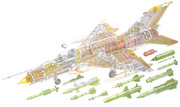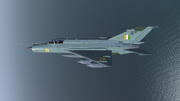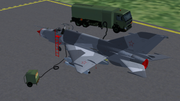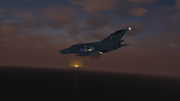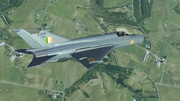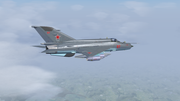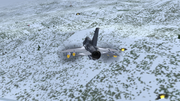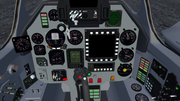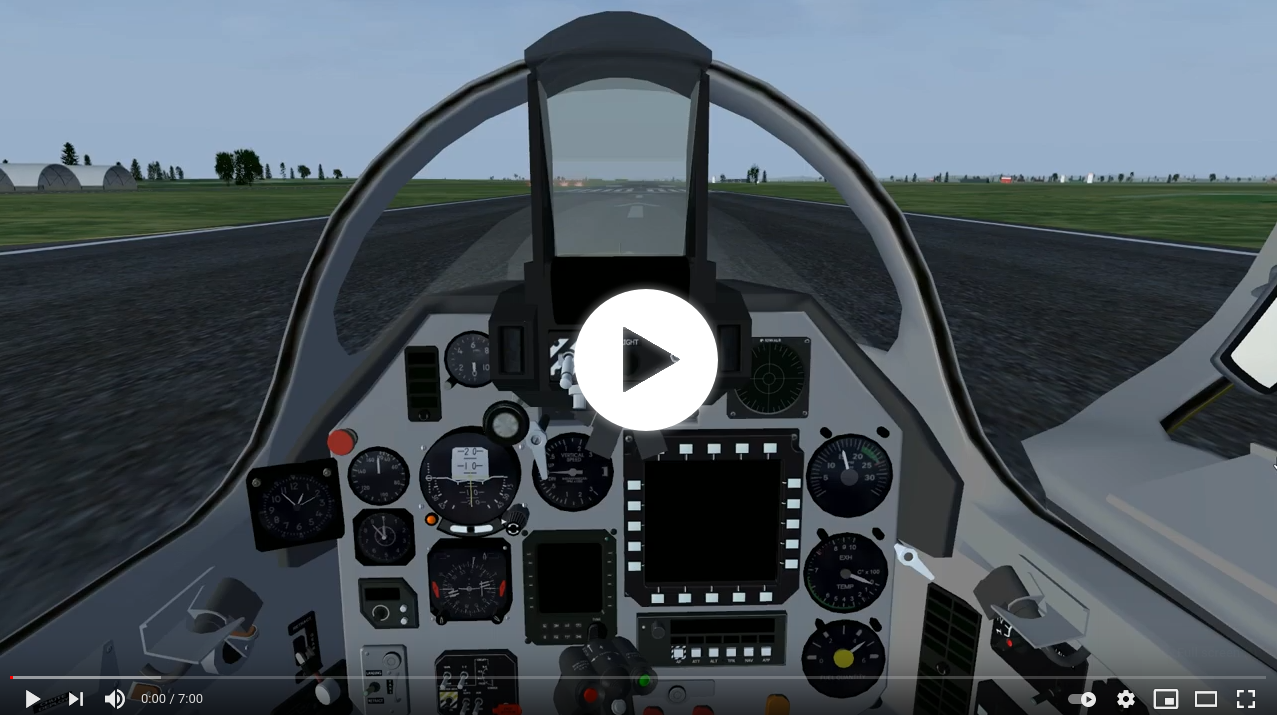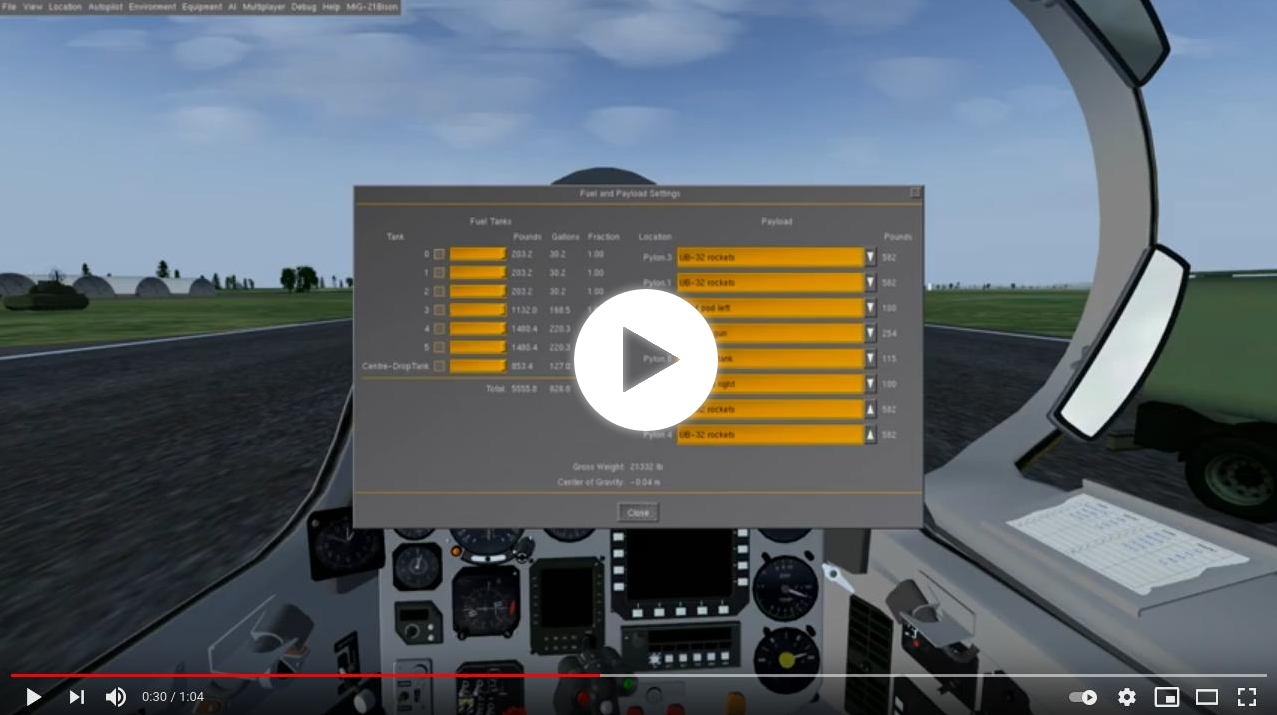MiG-21UPG
Addon Aircraft for Flightgear
Project maintained by Sky4Viper Hosted on GitHub Pages — Theme by mattgraham
MiG-21UPG
This is a rework of pjedvaj’s Mig-21bis. Currently only yasim is supported. There’s still a lot of work left - electrical system, hydraulics, cockpit flood lights, radar and guided missiles. But there’s already a lot of functioning swiches to press :). Not very accurate to be honest, it is more of a look alike concept. As well as me learning to code for flightgear. Have fun!
This is an addon Aircraft for Flightgear. MIG-21UPG (also known as MiG-21-93 and MiG-21Bison) is an upgraded version of MiG-21bis used by IAF There isn’t much information about it, therefore a lot of aspects are highly speculative. Anyway I think it is an interesting aicraft that deserves some attention. Original MiG-21bis I decided to use as a base was released by pjedvaj http://fguk.eu/index.php/hangar/download/7-military-jets/101-mikoyan-gurevich-mig-21bis
Reference sources:
Payload: http://www.airwar.ru/image/idop/fighter/mig21-93/mig21-93-1.gif
Views: http://www.airwar.ru/image/idop/fighter/mig21-93/mig21-93-2.gif
Cockpit: http://www.airwar.ru/image/idop/fighter/mig21-93/mig21-93-9.jpg
Armament: http://www.airwar.ru/image/idop/fighter/mig21-93/mig21-93-10.jpg
Cutout: https://forums.eagle.ru/attachment.php?attachmentid=118049&d=1432875892
Historical background
MiG-21-93 Upgrade The high performance of the MiG-21 aircraft, which is the most popular supersonic fighter in the world, enables to effectively solve a wide range of flight missions even today.
The RAC “MiG” jointly with the SOKOL aircraft-building plant of Nizhniy Novgorod and in cooperation with other Russian enterprises and organizations have worked out the upgrade program of the MiG-21 family aircraft, aimed at expansion of armament nomenclature and modes of its application that allow these aircraft to be still successfully operated by Air Force of different countries for some years. Combat capabilities of upgraded MiG-21 aircraft correspond to those of the up-to-date fourth generation fighters.
The upgrade project offered by RAC “MiG” and named MiG-21-93 is based on the use of “Kopyo” (“Spear”) airborne radar, new weapons and equipment. This project has been developed jointly by RAC “MiG”, Phazotron-NIIR Company, GosNIIAS and “Sokol” Joint-Stock Company under the general patronage of “Rosvooruzhenye” company. Due to high technical characteristics and reasonable cost, the project has won the Indian tender for MiG-21 fleet retrofitting. The “Kopyo” radar is designed for controlling the full aircraft weapons spectrum: built-in gun, rockets, advanced missiles with homing heads and guided bombs. This makes it possible to enhance qualitatively the MiG-21 following characteristics:
- air target detection and lock-on range both in look-up and look-down with using R-27 and RVV-AE middle-range missiles ( the latter can be launched against several targets simultaneously);
- ground and sea-surface target detection and improved communication, EW and navigation aids;
- air target detection and engagement range in action in the front hemisphere;
- improved guidance and engagement capabilities in action against ground targets of any type;
- track-while-scan mode with the capability of tracking up to 10 targets and engaging two of them;
- capability to battle successfully with forth-generation fighters;
- effective destruction of ground targets covered by enemy air defense.
In accordance with the Indian party request, a number of systems of Western and Indian make have been combined in a single avionics complex.
The main objective of the MiG-21-93 project was to achieve the maximum combat effectiveness with minimum aircraft changes and extend the service life of this reliable aircraft (up to 40 years and 4,000 flying hours). Also, this rational approach to MiG-21 upgrade allows the Customer to save great funds to the utmost. Essentially the tests of the aircraft had been completed and the series production of the upgraded MiG-21bis aircraft for the Indian Air Force was launched.
In 1998-2005 the Indian Air Force upgraded fundamentally 125 MiG-21 fighters on the basis of the MiG-21-93 project developed by the RAC “MiG”. In the course of upgrading the MiG-21bis was equipped with a new armament control system including the multi-function radar “Kopyo”, helmet-mounted target designation system, data display equipment based on the up-to-date head-up and multifunctional displays.
The radar “Kopyo”, designed by the “Fazatron-NIIR” Corporation, provides for the acquisition and attack of targets (including with the middle-range missiles) in look-up and look-down as well as the detection of radar-contrast surface and ground targets. The radar “Kopyo” is capable to track up to 8 targets and attack simultaneously two most dangerous ones. The radar has the terrain mapping mode.
The fighter is equipped with new systems of navigation, communication, electronic counter measure, video recording, integrated system of monitoring, recording and processing of the flight data. The electrical supply and air conditioning systems have been improved.
The fighter weapon suite is significantly expanded: it is added with RVV-AE, R-27R1, R-27T1, R-73E “A-A” missiles and KAB-500Kr guided bombs. Concurrently with upgrading the aircraft service life and lifetime can be extended.
At the customer’s request the available MiG-21 aircraft of the customer can be subjected to upgrading of various complexity level and provided with equipment and armament of foreign production.
MiG-21-93 Upgrade - Program The MiG-21 aircraft was inducted in the Indian Air Force from the year 1963 to 1976. The indigenised production of MiG-21 Bis aircraft continued till 1989. Taking average life of 35 years, the majority of these aircraft had considerable residual life left. The average life of MiG-21 in the world is about 3,000 flying hours whereas aircraft in the Indian fleet had flown only 1,600 to 1,700 hours.
In 1989, Russia indicated that it could upgrade the MiG Bis aircraft with some of the avionics and weapons of MiG-29 aircraft. The preliminary proposal of Russia was received in November 1990 and detailed proposal in August 1991. A joint techno-economic study was carried out in November 1992 and the proposal was found to be comprehensive and cost effective. An intention to nominate Russia as prime contractor was issued in March 1994.
In March 1995, Russia agreed to upgrade India’s MiG-21 aircraft. The older generation aircraft like Hunter and Canberra were, as of that date, used in ancillary roles. Although MiG-21 is an aging aircraft, it remains fully airworthy consequence to regular maintenance checks and servicing procedure. Hence, MiG-21 remained in the Air Force for some more time till it is gradually phased out, after its Total Technical Life is fully exploited.
In December 1995, a proposal was submitted to CCPA (Cabinet Committee on Political Affairs) for approval of the upgradation of 125 MiG Bis aircraft with an option to upgrade 50 more aircraft at a total cost of US$ 626 million, equivalent to Rs. 2003 ( 1 US $ = Rs.31.99) crore including weapons, spares, maintenance support and training. Apart from components from Russia, the upgrade package consisted of certain Western and indigenous avionic systems.
CCPA approved the proposal in January 1996. The CCPA paper envisaged completion of design and development of two MiG Bis aircraft in Russia by 31 January 1998 and series modification of the remaining 123 aircraft indigenously by HAL by September 2001. Upgradation of the 50 aircraft under option was to be undertaken from 30 September 2001 onwards. MiG Bis upgradation program as approved by CCPA envisaged extension of TTL (Total Technical Life) of the MiG Bis fleet from 20 to 40 years for justifying the cost of upgradation.
The Ministry concluded six contracts in March 1996. Of these, three contracts, viz design and development of aircraft, series upgradation and armament were concluded with a Russian manufacturer and three contracts for avionic systems like INS (Inertial navigation System), CMDS ( Counter measures Dispensing System) and VRS ( Video Recording System) were concluded with Western vendors. Subsequently, the Ministry also concluded contracts with HAL, NAL (National Aerospace Laboratories) and BEL (Bharat Electronics Limited) in 1997 for development of indigenous avionic systems and life extension study.
In March 1996, the upgrade program offered by “MiG” Corporation and SOKOL aviation plant of Nizhniy Novgorod was launched to retrofit 125 MiG-21bis fighters produced under license by the HAL Corporation. This upgrade program allowed improving the fighter performance and equip it with the “Kopyo” multimode radar developed by the “Phasotron” Russian company. This airborne radar makes possible to feasibly enhance the detection range and capability to kill air and ground targets. The upgraded fighter is equipped with advanced avionics of Russian, Indian, French and Israeli design and armed with contemporary “air-to-air” and “air-to-surface” guided weapons.
The MiG-21bis upgraded fighter (designated Mig-21UPG) had performance and combat effectiveness on a par with contemporary fighters. In October 2000, for the first time MiG-21UPG launched RVV-AE missiles simultaneously at two air targets which proved the estimated performance and the flight tests carried in Russia were completed after a lapse of one month. At the end of December 2000, the first two upgraded MiG-21UPG fighters complete with documents and airborne equipment were delivered to the Indian side. Thus, the R&D stage was successfully completed and the Indian side will start the upgrading of the MiG-21bis fighters in from the year 2001.
The development of the RWR (Radar Warning Receiver) system was entrusted to ASIEO (Advanced Systems Integration and Evaluation Organisation) at a cost of Rs.10 crore with an objective to develop a compact Advanced Radar Warning Receiver system for fighter aircraft. Two systems were required to be supplied directly to the foreign manufacturer by June 1997 and the remaining 123 systems were to be supplied by BEL to HAL for upgrading the MiG Bis indigenously. A supply order on BEL for the supply of 123 systems including spares was placed in February 1997 at a cost of Rs.133.64 crore including FE of Rs.84.39 crore. As per supply order, the first six systems were to be supplied by March 1998 and the remaining by March 2001 in batches.
A total of 125 MIG-21 BIS variant aircraft had been planned for up-gradation. Out of these, two had been upgraded in Russia during the design and development phase. It had been planned that the remaining aircraft will be upgraded at HAL’ Nasik facility.
The first four MIG-21-93 fighters of the Indian Air Force, modernised with the assistance of Russian specialists, began test flights at the beginning of June 2001. India’s Hindustan Aeronautics Ltd. is working to modernise Russian-made aircraft of this type is underway. The modernisation of the second-generation MIGs will make it possible to turn them into multifunctional, multipurpose up-to-date fighters of the fourth generation with wide operational possibilities and high safety of flights. They are being fitted out with repeatedly improved firepower, delivery means and avionics, and their service life is extended till 2010-2015.
According to the existing plans, 125 MIGs which form the basis of India’s Air Force will be modernised step by step by the year of 2004. Besides the improved engines of Russian make, French and Israeli avionics is being installed on the fighters. The installation of the Russian multifunctional radar system Kopyo which simultaneously fixes eight targets and picks two most dangerous ones for an attack is the main element of the modernisation. The contract to the tune of 340 million dollars was signed by the two governments back in 1996. Under it, the specialists of the Russian enterprise MAPO-MIG have fully modernised two fighters at the Sokol plant in Nizhni Novgorod.
Experimental examples of the MiG-21UPG tactical fighter, intended for the Indian air force, successfully completed flight test and evaluation trials in 2001. Earlier referred to as the MiG-21-93 and later called the Bison, the UPG is a major upgrade of the long-serving MiG-21bis. This new variant, ordered by the Indian air force, differs from the “bis” in having a modern Phazotron-NfIR Kopyo multimode radar enabling use of state-of-the-art, air-to-air and air-to-surface missiles. Over 120 MiG-21bis could be eventually upgraded to the UPG standard in India under help from RSK MiG, Phazotron-NUR and Sokol aircraft plant of Nizhny Novgorod.

